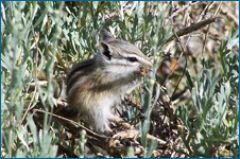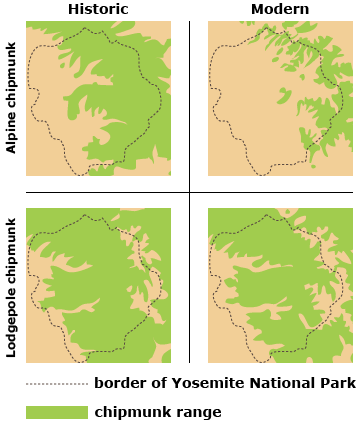
If you’d visited Tuolumne Meadows in Yosemite National Park 100 years ago, you probably would have encountered the alpine chipmunk, Tamias alpinus. Today, however, park visitors will have to hike up a nearby mountain to see one of these critters. That’s because this species is sensitive to temperature — and over the last hundred years of global climate change, Yosemite has warmed by about 5.5 degrees Fahrenheit. As the temperature increased, the chipmunks retreated to higher and higher elevations where it was cooler. Today, they occupy a fraction of their original range. If climate change continues, they could be squeezed right off the tops of their mountains and out of existence. Now, new research has revealed that the chipmunks (and probably other temperature-sensitive species) are losing not just territory and individuals, but genetic variation as well — a hidden threat that adds to the risk of extinction.
Where's the evolution?
Genetic variation refers to the idea that different individuals in a population are likely to carry different genetic sequences for corresponding regions of the genome. For example, in humans, one individual may carry genetic sequences that code for type A blood, and someone else may carry sequences that code for type O blood. Similarly, people may carry different sequences in regions of the genome that don’t code for anything at all. Both are examples of genetic variation. Populations that have fewer genetic differences from one individual to the next have lower levels of genetic variation.
In the case of the chipmunks, scientists were able to study DNA from museum specimens collected in the early 1900s and compare those to samples from chipmunks collected in the last 10 years. The modern chipmunks were much more genetically homogenous — i.e., had fewer different genetic sequences at the seven DNA regions studied — than their historic counterparts. Though the study only looked at a few non-coding regions, it is very likely that all parts of the chipmunks’ genome — those that help produce important traits, as well as those that don’t code for anything — have lost genetic variation.
Climate change is the obvious culprit. As shown on the maps below, the range of the alpine chipmunk (and almost certainly, its population size) has decreased significantly over the last 90 years as the climate has warmed. And of course, as the population lost individuals, it also lost the genetic variants they carried, reducing its level of genetic variation. For comparison, the lodgepole chipmunk, T. speciosus, is not as finicky and has maintained its historic range despite the heat. When scientists studied the lodgepole chipmunk, they found similar levels of genetic variation in historic and modern samples. Since the main difference between the two species seems to be their response to rising temperatures, climate change is the most likely cause of reduced genetic variation in the alpine chipmunk.
What does reduced genetic variation mean for the future of the alpine chipmunk? There are several implications:
- First, it corroborates the idea that the population is shrinking and becoming more fragmented — i.e., small subpopulations are being cut off from one another. Both of these factors increase the species’ chance of extinction.
- Second, since genetic variation is the raw material of evolution, it reduces the ability of the species to evolve in response to future changes in its environment. Natural selection acts on genetic variation, increasing the frequency of those gene versions that are advantageous in a species’ current situation. If the right gene versions aren’t present in a population, adaptation will not occur. So for example, if the chipmunks were to face a new, deadly pathogen introduced by an invasive species, there may not be any individual in the population carrying gene versions that allow it to resist the pathogen, and hence, the population could be wiped out. In a more genetically variable population, this sort of thing is less likely to happen.
- Third, low levels of genetic variation can lead to decreased survival and reproductive rates through inbreeding depression. When individuals in a population are very similar to one another genetically, it can mimic a situation in which close relatives mate and can lead to reduced fitness of offspring (see boxed text). If this occurs, the chipmunks would suffer poor health and diminished reproductive rates as a result of their low levels of genetic variation.
What causes inbreeding depression?
Natural selection is efficient at weeding disadvantageous gene versions out of a population if the gene versions are dominant. However, disadvantageous gene versions that are recessive can remain in a population for a long time. Because of this, all populations are likely to carry plenty of “hidden” disadvantageous gene versions. Normally this isn’t a problem — except when close relatives mate and reproduce. Close relatives are likely to carry the same deleterious recessive gene versions, and hence, their offspring may inherit two copies of some deleterious recessive gene versions, allowing those disadvantageous effects to be expressed. When individuals from a population with little genetic variation mate with one another, it may lead to a similar outcome.
All three of these factors have the potential to increase extinction risk for the chipmunks.
Of course, at the moment, the chipmunks seem to be doing fine and are not listed as a threatened species. But the new research highlights the risks they are likely to face in the near future, as well as the risks faced by many other species whose ranges are contracting due to the warming climate. Alpine chipmunks are one of the few species for which we can easily examine changes in levels of genetic variation over the last century because we happen to have the right museum specimens. Many other high-altitude species have been moving uphill as well and are likely facing the same double-whammy that the chipmunks are — decreased population size and the hidden side effects of reduced genetic variation.
Primary literature:
- Moritz, C., Patton, J. L., Conroy, C. J., Parra, J. L., White, G. C., and Beissinger, S. R. (2008). Impact of a century of climate change on small-mammal communities in Yosemite National Park, USA. Science. 322: 261-264. Read it »
- Rubidge, E. M., Patton, J. L., Lim, M., Burton, A. C., Brashares, J. S., and Moritz, C. (2012). Climate-induced range contraction drives genetic erosion in an alpine mammal. Nature Climate Change. 2: 285-288. Read it »
News articles:
- A short blog post on the topic from KQED News
- A press release about the research from the UC Berkeley News Center
- A brief article and video describing the research from The Daily Californian
Understanding Evolution resources:
- A tutorial on genetic variation
- A brief explanation of inbreeding depression
- A reader on the many ways in which evolutionary theory informs conservation efforts
Background information from Understanding Global Change:
- Why is genetic variation so important to evolution?
- Why would a shrinking population lead to decreased genetic variation?
- How and why does genetic variation affect a population’s ability to survive attacks by pathogens and parasites?
- The study described above examined genetic variation in seven non-coding regions of the chipmunk genome. Since the regions don’t code for any useful traits, how could this research have any implications for the future evolution of the chipmunks?
- Do some research and describe what aspects of genetics were understood and what aspects were not understood in 1915/1916 (the years that historic chipmunk specimens were collected from Yosemite). Do you think that the original collector of these specimens anticipated how they would ultimately be used? Explain your reasoning.
- Advanced: Imagine a locus in the chipmunk genome with two alleles A and a. A is dominant and advantageous, while a is recessive and deleterious — it causes poorer than average vision. The frequency of A in the population is 0.95 and the frequency of a is 0.5. Assume that the population is in Hardy-Weinberg equilibrium.
a. What percent of the population has the Aa genotype?
b. What percent of the population has poor vision caused by the aa genotype?
c. If the population mates randomly, in what percentage of matings will an Aa individual mate with another Aa individual?
d. In what percentage of the matings will an AA individual mate with an Aa individual?
Now imagine that two unrelated individuals (one with the genotype AA and one with the genotype Aa) mate and produce 20 pups over the course of their lifetimes.
e. What percentage of the pups would you expect to be carriers of the a allele?
f. How many pups would you expect to be carriers of the a allele?
g. What percentage of the pups would you expect to have poor vision?
Now imagine that this set of pups is isolated from other chipmunks and the pups wind up mating with each other — i.e., with siblings.
h. If the sibs mate randomly with one another, in what percentage of matings will an Aa individual mate with another Aa individual?
i. In those cases (when an Aa sib mates with another Aa sib), what percentage of the offspring will have poor vision?
j. Assuming no other ill effects of inbreeding, what percentage of the grandchildren of the original AA/Aa breeding pair, would you expect to have poor vision?
- Teach about genetic variation: In this lesson for grades 9-12, students conduct a classwide inventory of human traits, construct histograms of the data they collect, and play a brief game that introduces students to major concepts related to human genetic variation and the notion of each individual's uniqueness.
- Teach about genetic variation and conservation: This lesson for grades 9-12 uses paper chromatography to simulate electrophoresis of DNA. The problem posed is to identify the genetic similarities among several sub-species of wolf in order to provide information for a conservation/breeding program.
- Teach about genetic variation and conservation: This news brief for grades 9-16 describes a conservation plan to save the Florida panther by infusing genetic variation into the population. This article comes with a set of discussion questions for use in the classroom, as well as links to related lessons.
- Moritz, C., Patton, J. L., Conroy, C. J., Parra, J. L., White, G. C., and Beissinger, S. R. (2008). Impact of a century of climate change on small-mammal communities in Yosemite National Park, USA. Science. 322: 261-264.
- Rubidge, E. M., Patton, J. L., Lim, M., Burton, A. C., Brashares, J. S., and Moritz, C. (2012). Climate-induced range contraction drives genetic erosion in an alpine mammal. Nature Climate Change. 2: 285-288.

